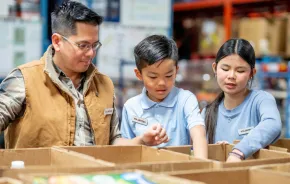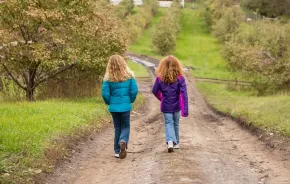 Darell Hammond, CEO and founder of KaBOOM!, grew up with seven brothers and sisters at the Mooseheart Child City & School, a residential group home outside of Chicago. There, he learned about volunteerism and leadership, and began to understand that great playgrounds make a big difference to kids’ development.
Darell Hammond, CEO and founder of KaBOOM!, grew up with seven brothers and sisters at the Mooseheart Child City & School, a residential group home outside of Chicago. There, he learned about volunteerism and leadership, and began to understand that great playgrounds make a big difference to kids’ development.
KaBOOM! is a national nonprofit dedicated to creating play spaces across the country. Officially founded in 1996, the organization built its 2,000th playground this year at Imagine Southeast Public Charter School in Washington, D.C. Hammond is the author of the book KaBOOM! How One Man Built a Movement to Save Play.
Q: How did you come up with the idea of KaBOOM!?
In 1995, shortly after I moved to Washington, D.C., I read a news story about two children who suffocated to death while playing in an abandoned car because they didn’t have a place to play. That story still haunts me today, particularly because it could have been prevented. I wanted to help prevent future tragedies, provide children a great place to play and bring communities together with a common goal. That led to my first community playground build and what would eventually become KaBOOM!.
Q: How would you describe your mission?
The KaBOOM! mission is to help communities build great play spaces through the participation and leadership of communities, with the ultimate vision of having a playground within walking distance of every child in America.
One of our big challenges now is determining where playgrounds already exist and more importantly, where they do not. We have created an online, interactive Map of Play, where people can connect, share and discuss their favorite playgrounds. Parents can post safety issues, schedule play dates or share good news through our website or mobile apps. But more importantly, that map will help us locate the play deserts and then prioritize those areas for playground builds and other measures to bring great play spaces to every child in America.
Q: What influences and experiences in your life have inspired you?
Many people and experiences have inspired me throughout my life, but I credit my childhood at the Mooseheart Child City & School outside of Chicago, where I grew up with my seven brothers and sisters, with instilling in me the power of community and volunteerism and the desire to give to those less fortunate.
Q: Why do you think “play” is important for kids?
I know play is important for kids. An abundance of research tells us that play is critical to helping children develop socially, emotionally, academically and physically. There is a stark correlation between the lack of play and childhood obesity. In neighborhoods without a park or playground, the incidence of childhood obesity increases 29 percent.
Without ample play, we will continue to see a decrease in creativity and imagination, as well as vital skills including curiosity, social skills, resiliency and the ability to assess risk. Children who don’t play don’t learn how to work in groups, share, negotiate, resolve conflicts and advocate for themselves.
Studies have shown that schools without recess face increased incidence in classroom behavioral problems, including violence, emotional outbursts, and their students show a lack of ability to interact with peers and authority figures.
Q: Why has play taken a back seat to organized activities and more school time and academics?
Since the passage of No Child Left Behind, schools and teachers have been pressured to focus on standardized test results. There is a terrible misconception that play is a luxury, when in reality, it is an absolute necessity. Organized activities and academic study are important, but children also need to be able to exercise their bodies and their minds in ways that only unstructured, outdoor play allows them.
Q: Should our kids be playing while children in other countries are spending time learning—and gaining on U.S. kids in every academic area?
The irony is that while there is increased pressure to eliminate non-academic activities such as recess, play and physical activity, countries that do best academically also promote play. Children in China, Korea, Finland, Singapore and Japan are provided with playful schooling opportunities prior to second grade and have among the highest scores on international PISA [Programme for International Student Assessment] exam for 15-year-olds, ranked 1, 2, 3, 5, 8 respectively. The U.S. was ranked at number 13.
Q: Do today’s parents and educators put enough focus and emphasis on giving kids play time?
No. Kids are overscheduled, and in their free time, many choose to stay, or are kept, indoors, lulled by television, computers and video games. Recess is being eliminated from our nation’s schools. The fact is this generation has less time to play than any previous generation, something we call the “play deficit,” and it’s causing our children serious harm.
Q: Playgrounds have changed since I was a kid; we had concrete surfaces. Do you think we’ve gone too far in the other direction with our safety standards?
Fears surrounding lawsuits and safety are trumping common sense, resulting in sterile, uninspired play environments. Kids need to be able to take risks so they can develop critical thinking skills and learn to express themselves creatively.
Q: Should kids’ playgrounds be risk-free?
Of course playgrounds should be safe, but that is not the same as risk-free. Taking risks and making decisions is a critical part of a child’s development. We hinder that development if we allow our fears to create sterile, unimaginative playgrounds.
Q: How do you hope kids benefit from these playgrounds?
Our motto is “It starts with a playground,” because the idea is that this project sets the stage for a stronger, more empowered and more activated community.
Our playgrounds enable diverse groups of volunteers to collaborate toward a collective cause—the well-being of children—by completing a tangible product—a new playground—in a fixed time period—one day—that will make an immediate and lasting difference for decades to come.
KaBOOM! playgrounds are better utilized and better maintained than playgrounds that do not use the community-build model, because so much sweat equity has been invested by the time the playground is in place that it becomes a gathering place and often a spark for more community projects.
Linda Morgan is managing editor of ParentMap and author of Beyond Smart: Boosting Your Child's Social, Emotional, and Academic Potential.









